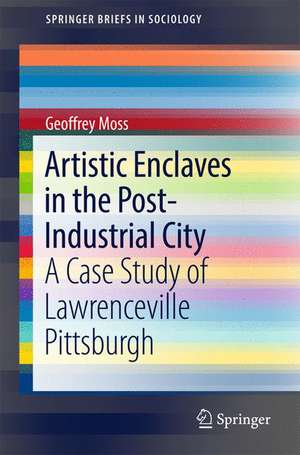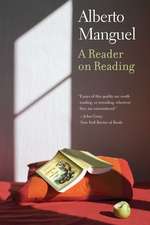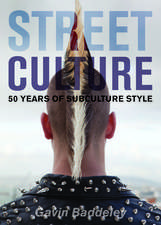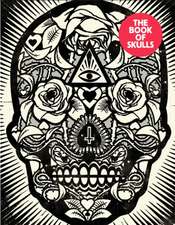Artistic Enclaves in the Post-Industrial City: A Case Study of Lawrenceville Pittsburgh: SpringerBriefs in Sociology
Autor Geoffrey Mossen Limba Engleză Paperback – 27 mar 2017
This SpringerBriefs presents a case study and theoretical analysis of an artistic enclave that emerged within Lawrenceville Pittsburgh. It briefly describes the history of greater Pittsburgh, and Lawrenceville’s transition from thriving blue-collar community to depopulated low-income neighborhood to gentrifying site of artistic and creative culture. It draws on multiple methods (e.g., interviews, observations, and survey data) to discuss the advantages and disadvantages associated with being a Pittsburgh artist, and offer a detailed description of the origins and ongoing development of Lawrenceville’s artistic enclave. It discusses this enclave in the context of sociological, historical, and interdisciplinary work on urban artistic communities (i.e., bohemian and quasi-bohemian communities), and situates it within the larger urban artistic tradition, and within its contemporary urban context. It maintains that this enclave constitutes a successful (i.e., sustainable) example of anartistic creative class enclave, a heuristic concept that clarifies and amends Richard Florida’s brief commentary on contemporary urban artistic life. It concludes by offering policy suggestions for those who wish to promote such enclaves, and a preliminary critical appraisal of their potential impact on society.
Din seria SpringerBriefs in Sociology
-
 Preț: 380.07 lei
Preț: 380.07 lei -
 Preț: 347.36 lei
Preț: 347.36 lei -
 Preț: 444.35 lei
Preț: 444.35 lei -
 Preț: 379.86 lei
Preț: 379.86 lei -
 Preț: 381.21 lei
Preț: 381.21 lei -
 Preț: 378.54 lei
Preț: 378.54 lei -
 Preț: 376.59 lei
Preț: 376.59 lei -
 Preț: 447.62 lei
Preț: 447.62 lei -
 Preț: 379.68 lei
Preț: 379.68 lei -
 Preț: 380.25 lei
Preț: 380.25 lei -
 Preț: 361.03 lei
Preț: 361.03 lei -
 Preț: 175.76 lei
Preț: 175.76 lei -
 Preț: 379.86 lei
Preț: 379.86 lei -
 Preț: 413.45 lei
Preț: 413.45 lei -
 Preț: 375.45 lei
Preț: 375.45 lei -
 Preț: 413.84 lei
Preț: 413.84 lei - 15%
 Preț: 463.68 lei
Preț: 463.68 lei -
 Preț: 376.59 lei
Preț: 376.59 lei -
 Preț: 444.74 lei
Preț: 444.74 lei -
 Preț: 174.44 lei
Preț: 174.44 lei -
 Preț: 375.84 lei
Preț: 375.84 lei -
 Preț: 379.68 lei
Preț: 379.68 lei -
 Preț: 260.18 lei
Preț: 260.18 lei -
 Preț: 376.59 lei
Preț: 376.59 lei -
 Preț: 380.63 lei
Preț: 380.63 lei -
 Preț: 261.15 lei
Preț: 261.15 lei -
 Preț: 263.67 lei
Preț: 263.67 lei -
 Preț: 346.86 lei
Preț: 346.86 lei -
 Preț: 342.03 lei
Preț: 342.03 lei -
 Preț: 260.38 lei
Preț: 260.38 lei -
 Preț: 343.39 lei
Preț: 343.39 lei -
 Preț: 378.34 lei
Preț: 378.34 lei -
 Preț: 410.94 lei
Preț: 410.94 lei -
 Preț: 376.59 lei
Preț: 376.59 lei -
 Preț: 377.73 lei
Preț: 377.73 lei
Preț: 378.34 lei
Nou
Puncte Express: 568
Preț estimativ în valută:
72.39€ • 75.79$ • 59.90£
72.39€ • 75.79$ • 59.90£
Carte tipărită la comandă
Livrare economică 05-19 aprilie
Preluare comenzi: 021 569.72.76
Specificații
ISBN-13: 9783319552620
ISBN-10: 3319552627
Pagini: 110
Ilustrații: XIV, 110 p. 16 illus.
Dimensiuni: 155 x 235 x 7 mm
Greutate: 0.19 kg
Ediția:1st ed. 2017
Editura: Springer International Publishing
Colecția Springer
Seria SpringerBriefs in Sociology
Locul publicării:Cham, Switzerland
ISBN-10: 3319552627
Pagini: 110
Ilustrații: XIV, 110 p. 16 illus.
Dimensiuni: 155 x 235 x 7 mm
Greutate: 0.19 kg
Ediția:1st ed. 2017
Editura: Springer International Publishing
Colecția Springer
Seria SpringerBriefs in Sociology
Locul publicării:Cham, Switzerland
Cuprins
Chapter 1. Introduction.- Chapter 2. Florida’s Creative Class Thesis.- Chapter 3. The Larger Urban Context.- Chapter 4. Bohemia: Introduction and Classic Prototypes.- Chapter 5. The Growing Integration of Bourgeois and Bohemian Culture.- Chapter 6. Lawrenceville’s Artistic Enclave.- Chapter 7. An Alternative to the Dominant Academic Narrative.- Chapter 8. Summary and Conclusion.
Notă biografică
Geoffrey Moss is currently a full-time Associate Professor of Instruction in Sociology at Temple University. He received a Ph.D. in Sociology and Education from Columbia University, an M.A. in Organizational Psychology from Columbia University-Teachers College, an M.A. in Criminal Justice from John Jay College of Criminal Justice, and a B.A. in Economics from Queens College of the City University of New York. He is a member of the American Sociological Association, Urban Affairs Association, and Phi Beta Kappa. He has published articles in the Journal of Criminal Justice, Economic and Industrial Democracy, and School Organization. His interest in artistic communities was sparked by his parents, David and June Moss, who were part of New York’s 1950’s bohemian theatre scene, and nourished by frequent visits to artistic communities in New York and other cities. This is his first work on artistic communities. He is currently studying an artistic community that emerged within Philadelphia’sFishtown/Kensington area. He lives in Plymouth Meeting PA with his wife, Kay Williams, an RN at Chestnut Hill Hospital. Ms. Williams helped him to collect data for his study of Lawrenceville Pittsburgh.
Caracteristici
Clarifies, builds on and amends Richard Florida’s comment that bohemian artists have become part of a larger creative class Defines a new heuristic type, the artistic creative class enclave, and presents an elaborate typological analysis of the similarities and differences between artistic creative class enclaves and other types of artistic enclaves Discusses the benefits and limitations of artistic creative class enclaves for communities, cities, and postindustrial society Demonstrates that Lawrenceville’s artistic creative class enclave, unlike the relatively bohemian enclaves described in previous studies, and the artistic enclaves briefly described by Florida, has achieved long-term sustainability within its postindustrial urban context Makes policy suggestions designed to help those who wish to promote sustainable artistic enclaves Includes supplementary material: sn.pub/extras










